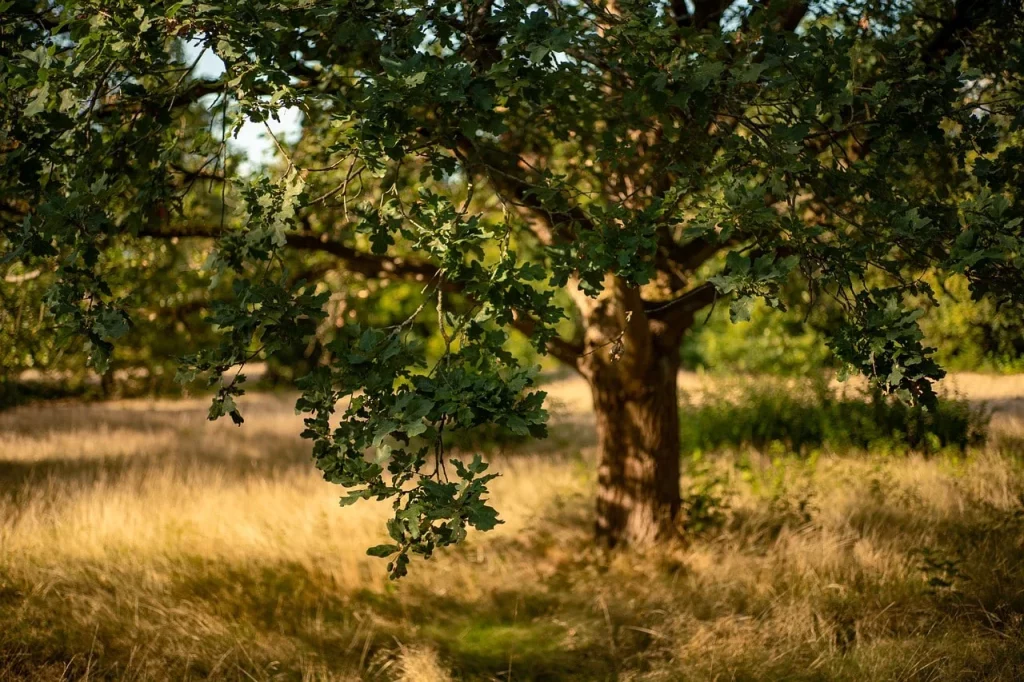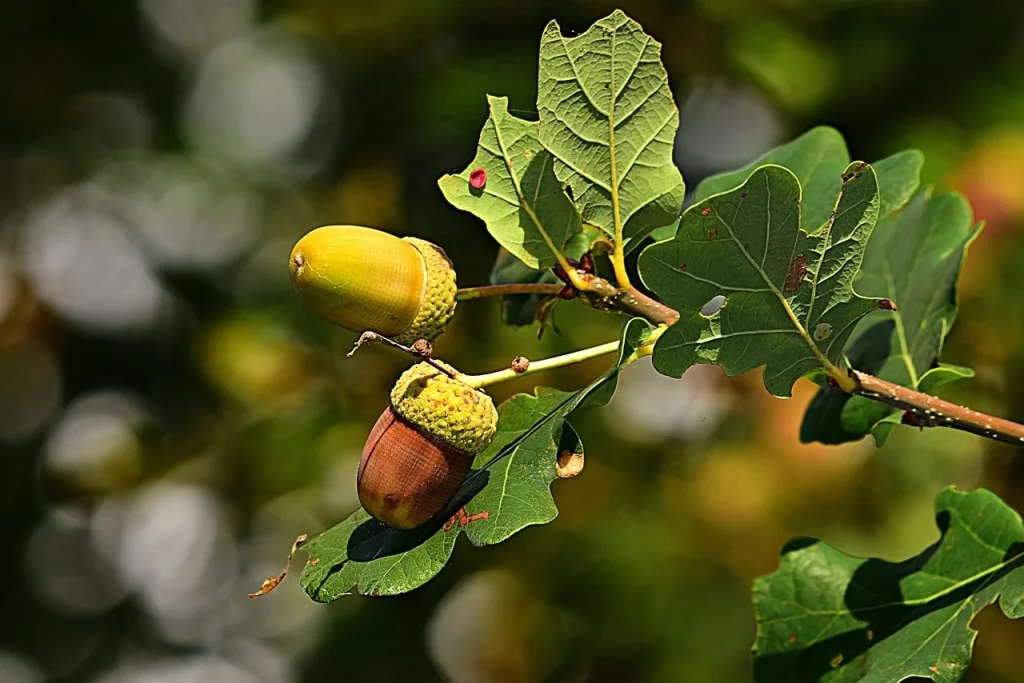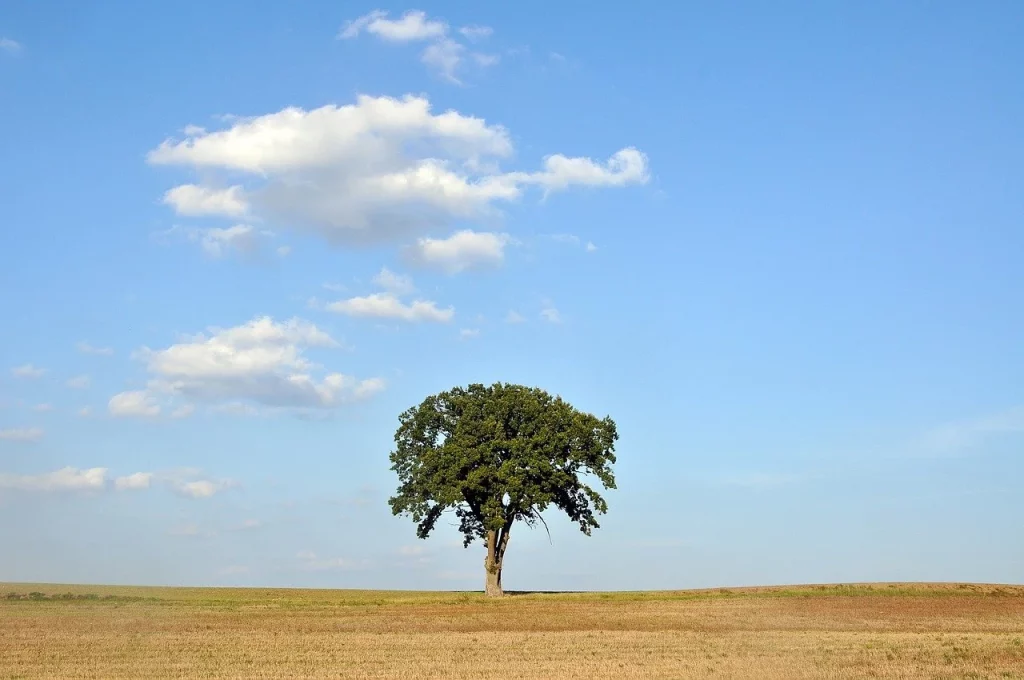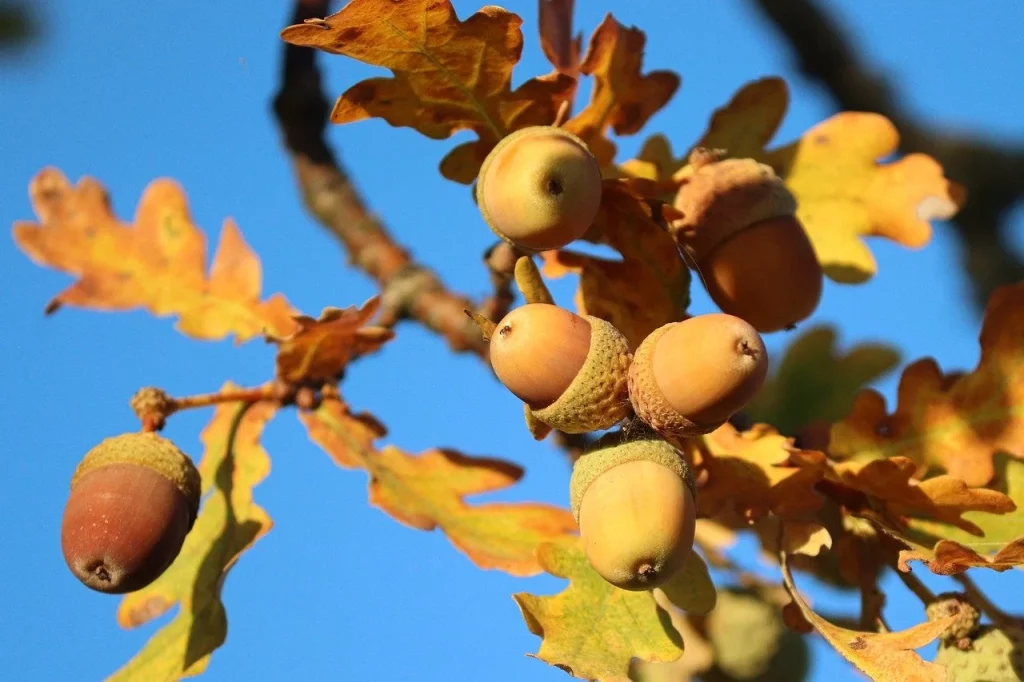Let’s talk about oak trees, the Internet celebrities of the forest. With their sprawling branches and timeless charm, it’s no wonder they’ve been the backdrop for countless photos and stories. But there’s more to these trees than just good looks.
In this exploration of some interesting oak tree facts, we’ll uncover the secrets of their survival, their contribution to ecosystems, and how they’ve stood the test of time (and weathered more than a few storms).
From the mystery of their acorns to the wildlife that calls them home, they are full of surprises. And just when you thought you knew everything about them, we’ll ask the question: have you ever considered what makes an oak tree’s bark so unique? Let’s find out.
The creation of a thousand forests is in one acorn.
Ralph Waldo Emerson
Oak Tree Facts
Dive into their world with the fascinating facts that follow. Read carefully, because I created a quiz for you at the end of the page to test your newfound knowledge. Don’t disappoint me.
- The lifespan of these majestic trees can exceed 400 years, making them witnesses to centuries of human history.
- These trees can “communicate” and share nutrients through a network of fungi interconnected with their roots, a phenomenon known as the Wood Wide Web.
- The bark of these trees contains tannin, a substance once crucial for leather tanning, significantly impacting historical economies.
- One species, the Cork Oak, has bark that can be harvested every 10 years without harming the tree, providing a sustainable material for wine bottles and more.
- The leaves and acorns of certain types of these trees have been used in traditional medicine for their anti-inflammatory properties.
- Acorns were a vital food source for indigenous peoples, offering a rich source of protein and fats.
- A single mature tree can produce up to 10,000 acorns in a year, though only a tiny fraction grow into saplings.
- Their wood is highly valued for its strength and durability, making it a preferred material for furniture, flooring, and shipbuilding.
- Some species, like the white oak, are particularly resistant to water and rot, making them ideal for outdoor use.
- In Celtic mythology, these trees were sacred, symbolizing strength, endurance, and protection.
- During the American Revolution, the wood from these trees was essential for constructing naval ships.
- There are more than 600 species worldwide, each adapted to its specific environment.
- The largest specimen, known as the Pechanga Great Oak, is estimated to be over 2,000 years old.

- Some species play a critical role in the maturation of truffles, a type of highly prized fungus.
- Their leaves change color in autumn due to a decrease in chlorophyll production, revealing the vibrant pigments previously masked.
- A fully grown tree can consume about 50 gallons of water per day through its roots.
- Their complex root systems help prevent soil erosion, particularly in hilly and mountainous regions.
- Specific species have been instrumental in the development of winemaking, with barrels made from their wood imparting unique flavors.
- Not only humans benefit from these trees; they provide habitat and food for a wide range of wildlife, from birds to mammals.
- They have a remarkable ability to adapt to their surroundings, with some species thriving in waterlogged soils and others in drought-prone areas.
- One of the oldest known legal documents, the Charter Oak, famously hid Connecticut’s Royal Charter from British agents in 1687.
- The acorns of these trees are not immediately edible and must undergo a leaching process to remove tannic acid, making them safe for consumption.
- They play a significant role in folklore and literature, symbolizing wisdom and longevity in stories and poems.
- The density of their wood makes it a preferred choice for smoking meats, adding a rich flavor.
- In urban environments, they help improve air quality by absorbing pollutants and producing oxygen.
- Climate change impacts their distribution and growth, with rising temperatures and shifting rainfall patterns affecting their survival.
- Some species have leaves that stay green year-round, a trait known as evergreen, while others are deciduous, shedding their leaves annually.
- The resilience and hardiness of these trees make them a symbol of strength and sturdiness in various cultures.

- Historically, they were considered a sign of sovereignty and power, often planted to commemorate significant events and victories.
- The intricate patterns of their wood grain, along with its durability, make it a sought-after material for artisanal crafts and luxury goods.
- Their presence in a landscape can significantly increase property values, contributing to both aesthetic appeal and environmental health.
- Some species’ acorns contain high levels of fats and carbohydrates, serving as an essential food source for wildlife preparing for winter.
- They are among the most lightning-resistant trees, although they are not immune to strikes.
- Planting these trees is considered a beneficial action for the environment, as they help in carbon sequestration, mitigating the effects of climate change.
- Their expansive canopy provides shade and cooling, reducing the need for artificial cooling in nearby buildings and homes.
- Each type of these trees has a unique leaf shape, ranging from deeply lobed to nearly entire, reflecting a vast diversity within the genus.
- They are pivotal in creating and sustaining ecosystems, acting as keystone species in many forests and woodlands.
- Their wood’s natural resistance to fungal and insect attacks makes it an enduring choice for outdoor and structural applications.

- Species diversity is crucial for forest health, providing resilience against pests, diseases, and environmental changes.
- In many cultures, planting one of these trees is a traditional way to honor the birth of a child or commemorate a loved one.
- Their fallen leaves, rich in nutrients, decompose to form a vital part of the forest floor ecosystem, supporting a multitude of organisms.
- Their acorns were historically used as a form of currency in some societies, highlighting their value beyond just material uses.
- Despite their strength, they are susceptible to certain diseases and pests, which can significantly impact their health and longevity.
- The growth rings of these trees, visible in cross-section, can reveal much about past climate conditions, serving as natural archives.
- Some species have been known to migrate over time, slowly moving their dominant range in response to changing climate conditions and human activity.
- The flowers of these trees are not often celebrated, but they play a crucial role in the ecosystem, providing pollen for a variety of insects.
- Remarkably, the wood of these trees has been found in archaeological digs and preserved for thousands of years, offering insights into ancient woodworking techniques and tools.
- In certain traditions, carrying a piece of this tree’s wood is believed to protect against negative energies and encourage strength and resilience.
- Their ability to store vast amounts of carbon throughout their lifetime makes them invaluable allies in the fight against global warming.
- The intricate root systems of these giants are capable of drawing up water from deep underground, significantly influencing local water cycles and helping to stabilize groundwater levels.
Oak Tree Myths

After reading all these fun facts about oak trees, let’s now embark on a journey to separate the truth from the myth. Prepare to challenge what you know and expand your understanding.
- Oak Trees Only Grow in Warm Climates
It is commonly believed that they thrive solely in warm environments, but in reality, they are remarkably adaptable and can be found in a variety of climates. Oaks are native to both tropical and temperate regions, showing their versatility and resilience to different weather conditions. - Oak Trees Grow Quickly
The perception that they grow rapidly is widespread; however, they are known for their slow growth rate. This slow development contributes to the wood’s strength and density, making oak a highly valued material for furniture and construction. - Oak Trees Do Not Live Long
Contrary to the belief that they have a short lifespan, they are actually among the longest-living trees in the forest. Some species of oak trees can live for hundreds of years, with the oldest oaks reaching over a thousand years in age. - All Oak Trees Produce Acorns Annually
It is often assumed that all of them yield acorns every year, but the truth is, their production can be quite variable. Many oaks have a cyclical pattern known as masting, where they produce a large number of acorns in one year, followed by several years of minimal to no production. - Oak Leaves Always Turn Red in Fall
The belief that their leaves invariably turn red in the autumn is a common misconception. The color change in oak leaves during fall can vary greatly, with hues ranging from red and orange to yellow and brown, depending on the species and environmental conditions.
No products found.
Oak Tree Quotes

Let me share with you some of my favorite quotes from notable figures about these trees. Feel free to share yours in the comments so I can add them to the list as well.
Suburbia is where the developer bulldozes out the trees, then names the streets after them.
Bill Vaughan
Vaughan critiques suburban development practices humorously, pointing out the irony of destroying nature only to memorialize it in street names.
In the acorn lies the entire oak tree.
James Allen
Allen uses the acorn as a metaphor for potential, implying that greatness lies within even the smallest of beings, waiting to unfold.
The oak fought the wind and was broken, the willow bent when it must and survived.
Robert Jordan
Jordan draws a contrast between stubborn resistance and adaptable resilience, using the oak as a symbol of strength that, when inflexible, can lead to downfall.
He who plants an oak looks forward to future ages and plants for posterity.
Samuel Johnson
Johnson reflects on the act of planting oaks as a selfless, forward-thinking endeavor, symbolizing a commitment to the well-being of future generations.
The best time to plant an oak tree was twenty years ago. The second best time is now.
Proverb
This proverb emphasizes the importance of taking action in the present for future benefits, using the oak tree as a symbol of growth and time’s value.
Oak Tree FAQ

As we move on, we arrive at the FAQ section. Read these questions carefully because the quiz is just ahead.
- Does an oak tree have flowers?
Yes, they do have flowers! They might not be the showy flowers you’re picturing, though. Oak flowers are called catkins, and they’re more discreet, hanging down in long, slender clusters. These bloom in spring and are crucial for the tree’s reproductive process. - Are oak tree leaves poisonous?
No, their leaves are not generally considered poisonous to humans, but they can be toxic to certain animals, especially if eaten in large quantities. The leaves contain tannic acid, which can be harmful to livestock like cows and horses. - Can oak tree roots damage foundations?
Yes, their roots can potentially damage foundations. Like any large tree, the roots of an oak can grow extensively and might cause problems if the tree is too close to a building. They can disrupt pavement, plumbing, and even foundations if not monitored. - What oak tree produces acorns the fastest?
The White Oak (Quercus alba) is among the oak species that start producing acorns at a younger age, typically beginning to bear acorns when they are around 20 years old, which is relatively fast for oaks. - Are oak tree acorns edible?
Yes, their acorns are edible, but they require preparation to remove the tannins, which make them bitter. Once leached of tannins, acorns can be ground into flour or used in various dishes. However, it’s a process, so make sure you know how to prepare them properly before eating!
No products found.
Oak Tree Trivia

Welcome to our oak-tastic quiz! Remember, if you don’t get any questions right, you might just find yourself turning into an acorn at midnight. Let’s branch out your knowledge!
Conclusion
From their towering heights to their deep roots, oak trees embody resilience and beauty. They’ve weathered storms and seasons, providing shelter and sustenance to countless beings. As symbols of strength and growth, they inspire us to face challenges with grace and stand tall with hope.
Let’s honor these gentle giants by safeguarding their existence and learning from their wisdom. By caring for oak trees, we nurture a legacy of greenery and life for future explorers to cherish. Till next time, stay curious and explore more. Cheers.


